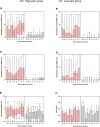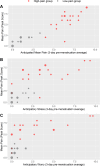Exploring the role of negative expectations and emotions in primary dysmenorrhea: insights from a case-control study
- PMID: 40399855
- PMCID: PMC12093753
- DOI: 10.1186/s12905-025-03784-2
Exploring the role of negative expectations and emotions in primary dysmenorrhea: insights from a case-control study
Abstract
Background: Primary dysmenorrhea, characterized by painful menstruation, significantly impacts the quality of life for women worldwide. Negative expectations and associated emotions are known to trigger nocebo effects and may also influence cyclic menstrual pain. In this study, we investigated the role of pain expectations and negative anticipatory emotions as potential contributing factors to hyperalgesia in women with severe menstrual pain, compared to women with absent or mild menstrual pain.
Methods: We conducted a prospective case-control study in women with severe menstrual pain due to primary dysmenorrhea, comparing them with age-matched women with absent or mild menstrual pain. Data collection included the Depression, Anxiety, and Stress Scale (DASS-21) at baseline, as well as daily numeric rating scales (NRS) to evaluate pain expectations, anticipatory negative emotions, and daily stress during the 10 days preceding menstruation. Saliva samples were collected to evaluate the Cortisol Awakening Response (CAR) before menstruation, and pain was assessed during the first 3 days of menstruation.
Results: Women with high menstrual pain reported significantly higher DASS-21 anxiety levels compared to low-pain controls, although still within the normal range (median [IQR], 3 [2; 5] vs. 1 [1; 3], p <.05). In the 10 days preceding menstruation, the high-pain group expected significantly higher maximum pain levels than controls (median [IQR], 8 [7.3; 8.5] vs. 2.1 [1; 3.3], p <.001), which aligned with their actual experiences of maximum pain during menstruation (6.5 [4.8; 7.7] vs. 1.2 [0.7; 2.3], p <.001). Anticipatory stress (2.1 [0.9; 4.2] vs. 0.2 [0; 0.9], p <.001), anticipatory anxiety (0.7 [0.0; 2.3] vs. 0 [0; 0], p <.001), anticipatory worry (1.3 [0.4; 2.6] vs. 0.1 [0; 0.3], p <.001), and anticipatory anger (0.7 [0; 1.5] vs. 0 [0; 0.2], p <.01) were also significantly higher in the high-pain group in the 10 days before menstruation. The CAR showed no significant differences between groups in the days before menstruation. Correlational analyses revealed multiple positive associations between expected pain levels, anticipatory negative emotions, and subsequently perceived levels of menstrual pain in both groups (all p-values < 0.05).
Conclusions: This pioneering study supports the hypothesis that cognitive-emotional factors such as heightened pain anticipation and negative emotions intensify menstrual pain severity in primary dysmenorrhea, although causal conclusions cannot be drawn from this observational study. Strategies aimed at optimizing expectations could play a significant role in managing primary dysmenorrhea.
Keywords: Anticipation; Anxiety; Hydrocortisone; Nocebo effect; Pain perception; Psychological stress.
© 2025. The Author(s).
Conflict of interest statement
Declarations. Ethics approval and consent to participate: The study protocol was approved by the Ethics Committee of Coburg University (approval number: HC-Meißner-20210324). All participants provided written informed consent. Consent for publication: Not applicable. Competing interests: The authors declare no competing interests.
Figures



Similar articles
-
Reduced quality of life when experiencing menstrual pain in women with primary dysmenorrhea.Acta Obstet Gynecol Scand. 2014 Feb;93(2):213-7. doi: 10.1111/aogs.12287. Epub 2013 Nov 25. Acta Obstet Gynecol Scand. 2014. PMID: 24266425
-
What we know about primary dysmenorrhea today: a critical review.Hum Reprod Update. 2015 Nov-Dec;21(6):762-78. doi: 10.1093/humupd/dmv039. Epub 2015 Sep 7. Hum Reprod Update. 2015. PMID: 26346058 Review.
-
Role of stress and physical activity on primary dysmenorrhea: A cross-sectional study.Narra J. 2024 Apr;4(1):e685. doi: 10.52225/narra.v4i1.685. Epub 2024 Apr 30. Narra J. 2024. PMID: 38798864 Free PMC article.
-
Factors Related to Primary Dysmenorrhea in Turkish Women: a Multiple Multinomial Logistic Regression Analysis.Reprod Sci. 2021 Feb;28(2):381-392. doi: 10.1007/s43032-020-00289-1. Epub 2020 Aug 11. Reprod Sci. 2021. PMID: 32780360
-
Exercise for dysmenorrhoea.Cochrane Database Syst Rev. 2019 Sep 20;9(9):CD004142. doi: 10.1002/14651858.CD004142.pub4. Cochrane Database Syst Rev. 2019. PMID: 31538328 Free PMC article.
References
-
- Proctor MML, Farquhar CM. Dysmenorrhoea. BMJ clinical evidence 2007, 2007.
-
- Iacovides S, Avidon I, Baker FC. What we know about primary dysmenorrhea today: a critical review. Hum Reprod Update. 2015;21(6):762–78. - PubMed
MeSH terms
Substances
LinkOut - more resources
Full Text Sources
Medical

